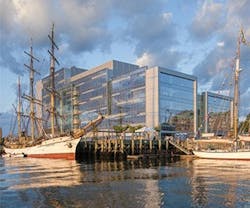Former Power Plant Earns LEED Platinum
Transforming a defunct coal-fired generating station into a sustainable and energy-efficient office is no easy feat, but the first LEED Platinum building in Atlantic Canada now graces the Halifax waterfront.
Housing approximately 600 employees for Nova Scotia Power, the renovation of the building (referred to as 1H after the substation originally operated there) focused on energy savings through strategic choices.
All project paybacks were designed to be achieved in 10 years or under. The retrofits made to Nova Scotia Power will save an estimated $650,000 a year in electricity and water bills.
This strategy was successful as the project achieved all 10 LEED Optimized Energy Performance points, will save 57% on energy compared to a conventional office, and earned an ENERGY STAR score of 89.
The project focused on the following strategies:
Curtainwall and Re-Skinning: A new exterior skin with low-E films on the glazing provides an improved thermal barrier. The frames of the curtainwall system also have improved thermal break to reduce heat transfer, and a new white roofing system decreases heat gain.
Harbor Heat Pumps: The mechanical system extracts sea water to run through the titanium heat exchanger while heat pumps transfer the needed cooling and heating from the circulation loop, sending it to the chilled beams and perimeter heating. The building is also able to move loads around during periods of simultaneous heating and cooling, only drawing from the harbor to make up the shortfall or reject excess load.
Chilled Beams: These induction units decrease energy use and increase thermal comfort. This solution maximizes the effectiveness of moving fresh air to where it is needed and removing stale air.
Efficient and Natural Lighting: Over 75% of occupied spaces have access to daylight as a result of the new skin. Occupancy and daylight sensors reduce or eliminate unnecessary lighting and T5/T8 fixtures are used where natural light isn’t adequate.
